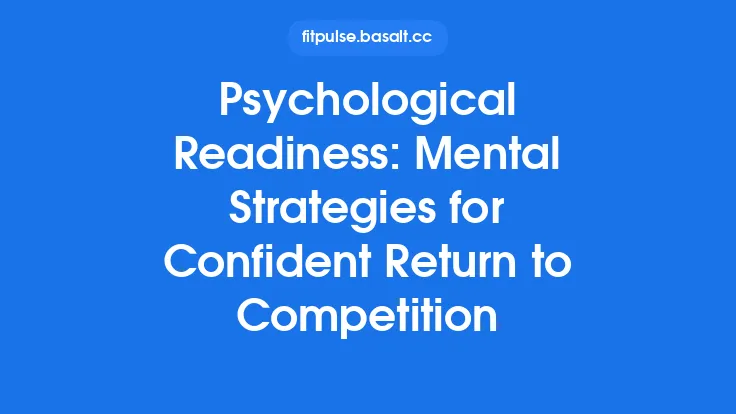Effective on‑court decision making does not happen by accident; it is the product of clear, consistent, and purposeful communication among teammates. When players understand each other’s intentions, anticipate movements, and convey information quickly, the collective intelligence of the team rises, leading to faster reads, smarter choices, and ultimately better performance. Below is a comprehensive guide to building and sustaining communication systems that enhance on‑court decision making across a variety of team sports.
The Foundations of Team Communication
1. Shared Language and Terminology
Develop a concise lexicon that all players use to describe positions, actions, and tactical cues. This includes:
- Positional codes (e.g., “2‑3” for a specific defensive alignment).
- Action verbs (e.g., “cut,” “slide,” “reset”).
- Signal modifiers (e.g., “quick,” “slow,” “high”).
A shared language reduces ambiguity and shortens the time needed to convey complex ideas during play.
2. Communication Hierarchy
Establish clear roles for who initiates, relays, and confirms information. Typical hierarchies include:
- Captain/On‑court leader – primary decision‑maker, initiates strategic calls.
- Positional leaders – secondary communicators who adjust tactics within their zone.
- Support players – provide feedback and confirm receipt of messages.
A defined hierarchy prevents overlapping commands and ensures that each player knows when to speak and when to listen.
3. Trust and Psychological Safety
Players must feel confident that their input will be valued and that mistakes will be treated as learning opportunities. Coaches can foster this environment by:
- Encouraging open debriefs after drills and games.
- Recognizing constructive communication, not just successful outcomes.
- Modeling calm, respectful exchanges during high‑pressure moments.
When trust is high, teammates are more likely to share real‑time observations that can alter the flow of play.
Verbal Communication Strategies
1. Pre‑Game Briefings
Use the pre‑game window to:
- Review the opponent’s tendencies and the team’s game plan.
- Assign specific verbal cues to anticipated scenarios (e.g., “Switch left” when the defense collapses).
- Conduct a quick “communication audit” where each player repeats the key cues to ensure retention.
2. In‑Game Call‑outs
Effective call‑outs are:
- Brief – one or two words.
- Specific – reference a location, player, or action (e.g., “Zone 4, press”).
- Consistent – use the same phrase each time the situation arises.
Practice these call‑outs in scrimmages until they become second nature.
3. Confirmation Loops
To avoid misinterpretation, incorporate a simple acknowledgment system:
- Sender: “Rotate right.”
- Receiver: “Right, rotating.”
The brief repeat backs the instruction, confirming that the message was heard correctly.
4. Noise Management
Crowd noise, arena acoustics, and opponent chatter can drown out verbal cues. Strategies to mitigate this include:
- Using hand‑signal augmentation (see non‑verbal section).
- Speaking directed toward the intended receiver rather than broadcasting.
- Employing pre‑determined volume cues (e.g., whisper for defensive adjustments, louder tone for offensive transitions).
Non‑Verbal Communication Techniques
1. Hand Signals and Gestures
Develop a set of universally understood hand signals for:
- Direction changes (pointing left/right).
- Speed modifiers (open palm for “slow,” clenched fist for “fast”).
- Play initiation (thumb up for “go,” two fingers for “reset”).
Practice these signals in low‑intensity drills to embed muscle memory.
2. Body Language and Positioning
Players can convey intent through subtle cues:
- Angle of approach – a defender angling their body can signal a trap.
- Eye contact – a quick glance can indicate a planned cut or pass.
- Foot placement – a player planting a foot can signal a pivot point for teammates.
Coaches should review video footage to highlight effective body‑language usage and correct ambiguous signals.
3. Spatial Awareness Cues
Use the court’s geometry as a communication aid:
- Zone occupancy – a player standing in a specific zone can signal a shift in defensive coverage.
- Proximity alerts – moving within a teammate’s “personal space” can indicate a need for a quick pass.
Training players to read and respond to these spatial cues sharpens collective decision making.
Integrating Technology into Communication
1. Wearable Audio Systems
Headsets with noise‑cancelling microphones allow captains to broadcast concise commands without being overpowered by crowd noise. When using such systems:
- Keep messages under three seconds.
- Use pre‑programmed voice prompts for common calls to reduce speaking time.
2. Real‑Time Data Overlays
Some sports now employ on‑court tablets or wrist‑worn displays that show:
- Opponent formation heat maps.
- Player fatigue indices.
These visual cues can supplement verbal communication, especially during time‑outs or halftime.
3. Video Review Apps
Post‑game, teams can use annotation tools to tag moments where communication succeeded or failed. This creates a searchable library of “communication case studies” for future reference.
4. Communication Drills with Simulated Distractions
Incorporate background noise recordings (crowd, music, opponent chatter) into practice to train players to maintain clear communication under realistic conditions.
Structured Communication Drills
1. “Echo” Drill
- Setup: Two lines of players facing each other, 10 m apart.
- Process: The first player shouts a cue (“Switch left”). The next player must repeat the cue verbatim before executing a movement. The chain continues down the line.
- Goal: Reinforce accurate transmission and quick acknowledgment.
2. “Signal Relay” Drill
- Setup: Small groups (3‑4 players) on half‑court.
- Process: The leader initiates a hand signal; each teammate must interpret and respond with the appropriate complementary signal within two seconds.
- Goal: Build fluency in non‑verbal cueing and reduce latency.
3. “Noise‑Chaos Scrimmage”
- Setup: Full‑court scrimmage with speakers playing crowd noise at 80 dB.
- Process: Teams must rely on pre‑determined signals and brief call‑outs to execute offensive sets.
- Goal: Test communication resilience under auditory stress.
4. “Decision‑Tree Role Play”
- Setup: Coach presents a series of game scenarios on a whiteboard (e.g., “Opponent presses high, ball in backcourt”).
- Process: Players discuss and assign the exact verbal and non‑verbal cues they will use to respond.
- Goal: Create a mental repository of ready‑made communication patterns for common situations.
Leadership Development for Communication
1. Captain Training
- Situational Awareness: Teach captains to read the flow of the game and anticipate communication needs before they arise.
- Message Framing: Emphasize concise phrasing and the use of positive reinforcement (“Great pressure, now rotate”).
- Emotional Regulation: Provide tools (breathing techniques, self‑talk) to stay calm, ensuring clear articulation under pressure.
2. Distributed Leadership
Encourage secondary leaders (e.g., point guard, center back) to take ownership of specific communication domains:
- Offensive orchestration – calling set plays, adjusting tempo.
- Defensive coordination – signaling switches, traps, and coverage changes.
This redundancy prevents a single point of failure if the primary leader is momentarily unavailable.
3. Peer Coaching
Pair experienced communicators with less confident teammates for short, focused feedback sessions after drills. Peer coaching reinforces learning and builds a culture of mutual accountability.
Evaluating Communication Effectiveness
1. Quantitative Metrics
- Turnover Ratio Linked to Miscommunication: Track the number of lost possessions directly attributable to unclear signals.
- Response Time: Measure the interval between a call‑out and the corresponding action using video timestamps.
- Signal Accuracy Rate: Percentage of correctly executed hand signals during drills.
2. Qualitative Assessment
- Player Surveys: Periodic anonymous questionnaires asking players to rate clarity, confidence, and perceived effectiveness of team communication.
- Coach Observations: Structured checklists noting instances of successful or failed communication during games.
3. Continuous Improvement Loop
- Collect Data (post‑practice/game).
- Analyze (identify patterns, high‑risk moments).
- Adjust (refine cues, add new signals, modify hierarchy).
- Re‑train (integrate changes into the next practice cycle).
A systematic feedback loop ensures communication evolves alongside tactical developments.
Cultural and Contextual Considerations
1. Multilingual Teams
When players speak different native languages, prioritize universally understood symbols, gestures, and simple English phrases. Conduct brief language‑learning sessions focused on key terms.
2. Age and Experience Levels
- Youth Teams: Emphasize visual cues and simple call‑outs; keep the hierarchy flat to encourage participation.
- Professional Teams: Leverage complex signal systems and integrate technology, but maintain a clear chain of command.
3. Gender Dynamics
Research indicates that mixed‑gender teams may benefit from explicit agreements on communication styles to avoid assumptions about assertiveness. Establish norms that value both direct and collaborative communication.
Maintaining Evergreen Relevance
Communication strategies must stand the test of time, adapting to new tactics without losing core principles. To keep the system evergreen:
- Document all cues, hierarchies, and protocols in a living manual accessible to every player.
- Schedule Quarterly Reviews to purge outdated signals and incorporate emerging tactical trends.
- Encourage Player Ownership: Allow athletes to propose new cues when they encounter novel game situations.
- Cross‑Sport Learning: Borrow effective communication practices from other team sports, adapting them to the specific spatial and temporal demands of your discipline.
By embedding these habits, the team’s communication framework remains robust, flexible, and continuously aligned with evolving competitive environments.
Final Takeaways
- Clarity, brevity, and consistency are the hallmarks of effective on‑court communication.
- Both verbal and non‑verbal channels must be cultivated, with redundancy built into the system to guard against noise and pressure.
- Leadership structures and trust are the social scaffolding that allow information to flow smoothly.
- Technology can augment but should never replace human interaction; it must be integrated thoughtfully.
- Deliberate practice, using targeted drills and realistic distractions, transforms communication from a reactive habit into a proactive skill.
- Measurement and feedback close the loop, turning data into actionable improvements.
When a team internalizes these strategies, each player becomes a reliable conduit of information, and collective decision making accelerates. The result is a more cohesive unit that can read the game, adapt instantly, and execute with precision—key ingredients for sustained success on the court.





